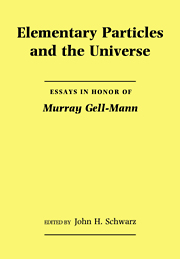Book contents
- Frontmatter
- Contents
- Preface
- Excess Baggage
- Through the Clouds
- Covariant Formulations of the Superparticle and the Superstring
- Chiral Symmetry and Confinement
- The Original Fifth Interaction
- The Mass Hierarchy of Leptons and Quarks as a New Symmetry
- Spacetime Duality in String Theory
- Supersymmetry and Quasi-Supersymmetry
- The Exceptional Superspace and the Quadratic Jordan Formulation of Quantum Mechanics
- Algebra of Reparametrization-Invariant and Normal Ordered Operators in Open String Field Theory
- Superconductivity of an Ideal Charged Boson System
- Some Remarks on the Symmetry Approach to Nuclear Rotational Motion
- Uncomputability, Intractability and the Efficiency of Heat Engines
- The New Mathematical Physics
- “Is Quantum Mechanics for the Birds?”
- The Gell-Mann Age of Particle Physics
- Remarks on the occasion of Murray Gell-Mann's more or less 60th Birthday
The Mass Hierarchy of Leptons and Quarks as a New Symmetry
Published online by Cambridge University Press: 11 November 2009
- Frontmatter
- Contents
- Preface
- Excess Baggage
- Through the Clouds
- Covariant Formulations of the Superparticle and the Superstring
- Chiral Symmetry and Confinement
- The Original Fifth Interaction
- The Mass Hierarchy of Leptons and Quarks as a New Symmetry
- Spacetime Duality in String Theory
- Supersymmetry and Quasi-Supersymmetry
- The Exceptional Superspace and the Quadratic Jordan Formulation of Quantum Mechanics
- Algebra of Reparametrization-Invariant and Normal Ordered Operators in Open String Field Theory
- Superconductivity of an Ideal Charged Boson System
- Some Remarks on the Symmetry Approach to Nuclear Rotational Motion
- Uncomputability, Intractability and the Efficiency of Heat Engines
- The New Mathematical Physics
- “Is Quantum Mechanics for the Birds?”
- The Gell-Mann Age of Particle Physics
- Remarks on the occasion of Murray Gell-Mann's more or less 60th Birthday
Summary
In the summer of 1970 I attended as a graduate student from MPI Munich the Brandeis Summer School on Theoretical Physics at Brandeis University. Afterwards I drove in a car which I had to deliver eventually in Long Beach, California, throughout the United States. This trip was not only my first encounter with the magnificent sceneries of the United States. On a short stay at the Physics Center in Aspen, Colorado, I met in a discussion with colleagues on problems of broken scale invariance Murray Gell–Mann for the first time.
The year 1970 was an exciting one in particle physics. After several years of frustration and little progress in experimental studies, the observation of the scaling phenomena in inelastic electron–nucleus scattering at SLAC had started a new era in particle physics. I had the hunch, like numerous other theorists, that the “SLAC scaling” might have something to do with scale invariance in field theory, the topic of my Ph. D. – thesis, which had been given to me by Heinrich Mitter at the MPI in Munich. In 1970 Gell–Mann was working, partially together with Peter Carruthers, on the problem of scale invariance and its breaking in hadron physics, a topic, which at a first sight seemed unrelated to the “scaling phenomenon” seen at SLAC. I remember a number of conversations I had with Murray at the Aspen Physics Center, in which we talked about possible connections.
- Type
- Chapter
- Information
- Elementary Particles and the UniverseEssays in Honor of Murray Gell-Mann, pp. 61 - 68Publisher: Cambridge University PressPrint publication year: 1991

